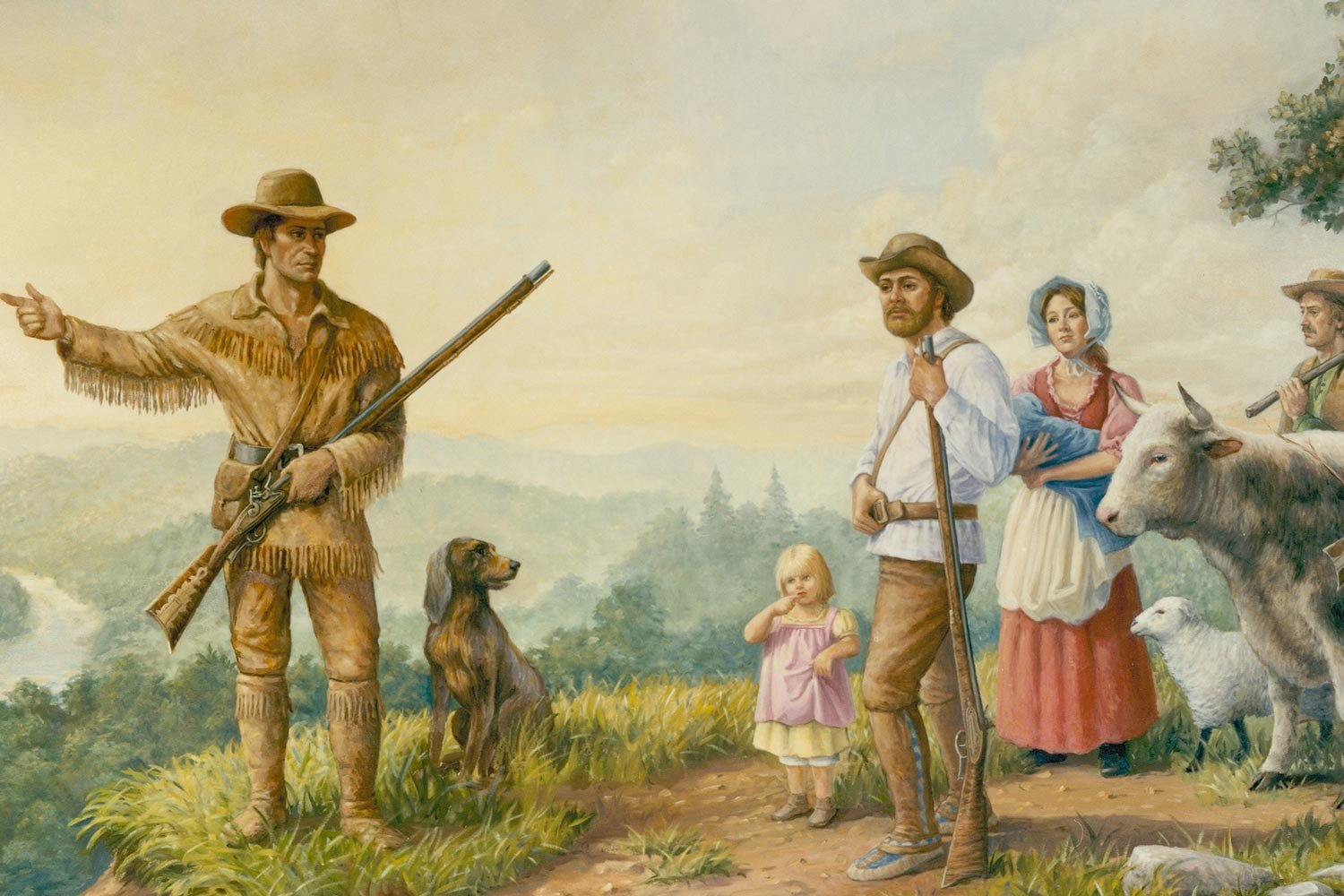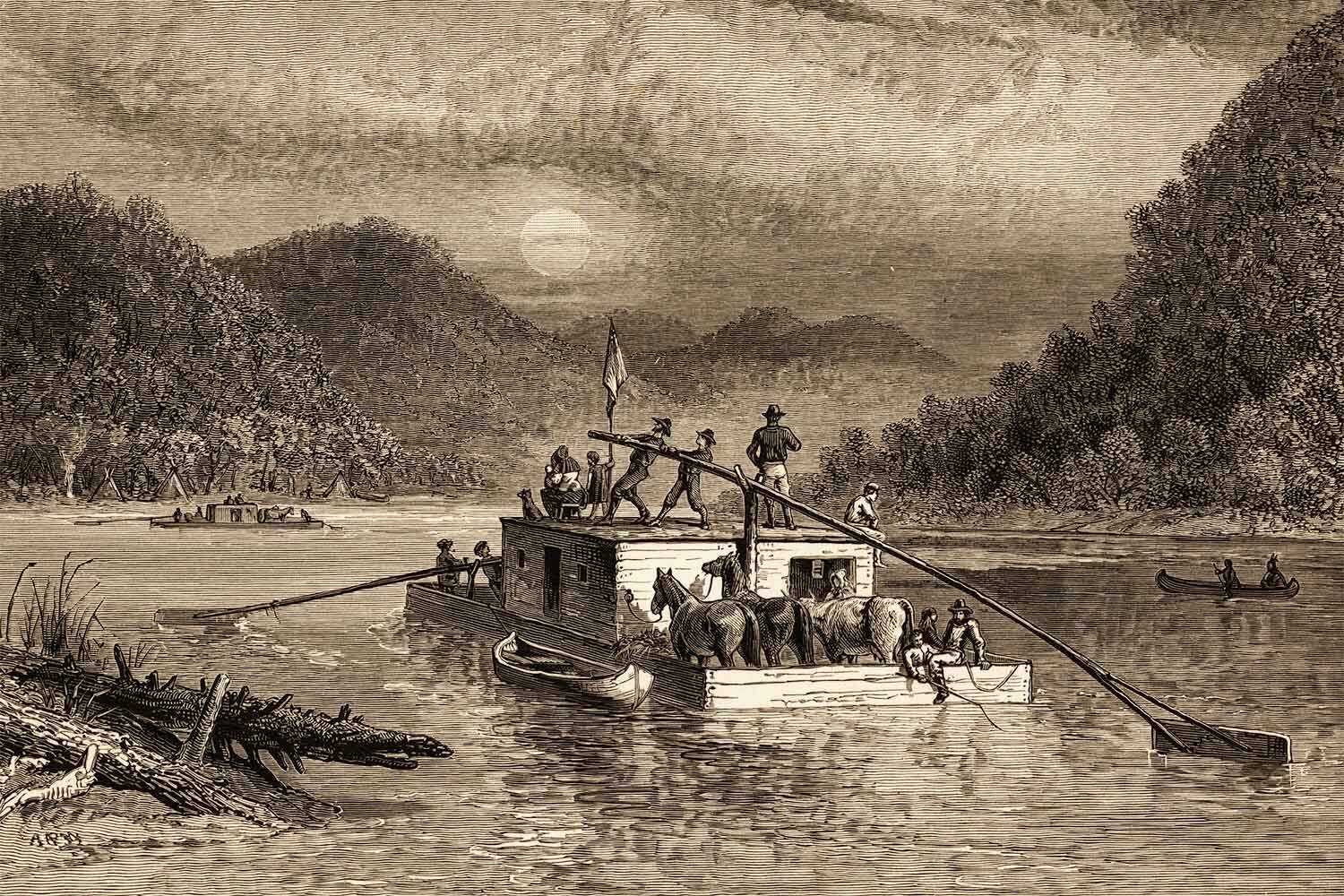Heading to Kentucky on the Wilderness Road
The Wilderness Road, running from northeast Tennessee through the Cumberland Gap, was the main thoroughfare for Americans heading west into the new promised land of Kentucky from 1775 to about 1820. The pathway, blazed by Daniel Boone, was our nation’s first migration highway, but the trip was not for the faint of heart.
Daniel Boone’s story is representative of the price paid by these early immigrants to Kentucky. He lost his son James to an Indian attack in 1773, and his brother Ned was killed by native warriors while hunting with Daniel in 1780. In 1776, his daughter Jemima was captured by the Shawnee (Boone rescued her two days later), and Daniel himself was captured and held prisoner by this same tribe for four months in 1778.
Additionally, many of the hardy souls who ventured to Kentucky in the early years were terribly poor. They had just landed in America and had little money to purchase supplies, work animals, or wagons for the trek. These unfortunate folks walked most of the way and used cattle to carry their heavier possessions.
Regardless of these hardships, courageous pioneers kept on coming. It is estimated that by 1810 almost 300,000 settlers had traversed the Wilderness Road on their way to the bountiful land beyond the hills. Once in central Kentucky, others such as Colonel Benjamin Logan, branched off from the Wilderness Road to explore and settle rich lands further north up to the Ohio River.
The Wilderness Road also became a main commercial thoroughfare for getting western goods to the rapidly expanding markets along the eastern seaboard. There was an almost constant train of hogs, cattle, sheep, and horses, as well as farm produce, heading east to supply the growing needs of the southeastern states.
“The National Road by Robert Bruce, National Highways Association, 1916.” Britannica.
Its heyday ended in about 1820 after the National Road, also known as the Cumberland Road, running through the Cumberland Narrows was opened. This northern route through gaps in the mountains of western Maryland ran from the Potomac to the Ohio and provided a more level route to the Ohio River Valley.
Five years later, in 1825, the Erie Canal opened in New York state which provided another easier alternative for Americans journeying to the Midwest.
Additionally, by the mid-1820s, steamboats plying the Ohio and Mississippi rivers had transformed travel to the west. This innovation had been introduced by Robert Fulton in 1811 when he debuted his steamboat the New Orleans.
Fulton’s invention greatly reduced the time required for settlers to reach the American west, as well as the rapidly growing tracts of the old Northwest Territory. Now, it made more sense for settlers heading west to use the National Road and the Ohio waterway to reach this new area.
The last flurry of activity for the Wilderness Road and the Cumberland Gap occurred during the Civil War when the area changed hands four times as both Federal and Confederate troops vied to control this strategic thoroughfare.
Following the end of the Civil War, the road fell into disuse except for local traffic. Today it is one of our national parks, simply a beautiful place to visit and hike. But in its day, the Wilderness Road, running through the Cumberland Gap, was an unparalleled pathway to America’s interior.
WHY IT MATTERS
So why should the history of the Wilderness Road and the Cumberland Gap matter to us today? This important road provided a pathway to the interior of the continent and access to land for three hundred thousand Americans. This drive west allowed our young nation to expand its boundaries and begin to harvest the region’s incredible bounty. Fortunately for us, our ancestors had that hardy American spirit and refused to be put off by the hardships they faced.
SUGGESTED READING
Blood and Treasure: Daniel Boone and the Fight for America’s First Frontier, written by Bob Drury and Tom Clavin, is an excellent book. It tells the story of Boone’s life and the conquest of America’s first frontier beyond the Appalachians.
PLACES TO VISIT
Cumberland Gap National Historical Park is a great place to visit. Located where Kentucky, Tennessee, and Virginia meet along the old Wilderness Trail, today’s US Route 25, you can tour the museum or hike to the crest of the gap and see what our ancestors saw so many years ago.
Until next time, may your motto be “Ducit Amor Patriae”, Love of country leads me.




One of the greatest American explorers from our founding era was Daniel Boone. A legendary woodsman, Boone helped to make America’s dream of westward expansion in the late 1700s a reality.